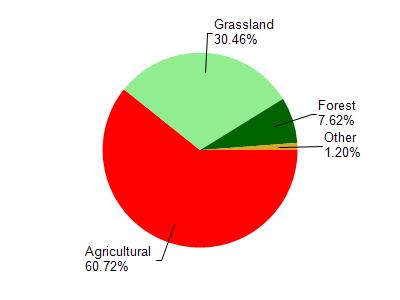Lafayette
Yes
No
No
Fish and Aquatic Life
Overview
This stream located east of Darlington flows toward the southwest and serves as a tributary to the Pecatonica River. Two good springs and a spring-fed feeder contribute two-thirds of the flow and make the stream viable for trout (Surface Waters of Lafayette County, 1967). It is classified as a Class II trout fishery, but interestingly, a 1980 survey found no evidence of reproduction. Also in 1980, a habitat project to prevent erosion resulted in stabilizing ½ mile of streambank with rip-rap and fencing off of one of the springs. The stream continues to be stocked with brown trout but has not been monitored recently.
Date 2002
Author Aquatic Biologist
Historical Description
This stream flows southwesterly into the West Branch of the Pecatonica River. Two good springs and a spring-fed feeder contribute approximately two-thirds of the total base flow. As a result, this stream is classified as good brown trout water. Brown trout are stocked annually since natural reproduction is limited. Rainbow trout are also present. There is also an abundant population of forage fishes. The stream bed consists of gravel with some silt near its mouth. The predominant watershed cover, is firm, open pasture on the streambanks and floodplain; and cropland with some woods onthe uplands. The watershed in general contains the common game species such as pheasants, squirrels, rabbits with some waterfowl near the West Branch of the Pecatonica River. There is no public ownership on this stream. Access from three town and one county road is considered adequate at the present time.
Lovetts Creek, T2N, R4E, Sections 17-5, Surface acres = 1.2, Miles = 4.3, Gradient = 21.0 feet per mile, Total alkalinity = 274 mg/l, Volume of flow = 3.5 c.f.s.
From: Piening, Ronald; Poff, Ronald; Threinen, C.W., 1967. Lake and Stream Classification Project. Surface Water Resources of Lafayette County, Wisconsin Department of Natural Resources, Madison, WI.
Date 1967
Author Aquatic Biologist
Condition
Wisconsin has over 84,000 miles of streams, 15,000 lakes and milllions of acres of wetlands. Assessing the condition of this vast amount of water is challenging. The state's water monitoring program uses a media-based, cross-program approach to analyze water condition. An updated monitoring strategy (2015-2020) is now available. Compliance with Clean Water Act fishable, swimmable standards are located in the Executive Summary of Water Condition in 2018. See also the 'monitoring and projects' tab.
Reports
Management Goals
Wisconsin's Water Quality Standards provide qualitative and quantitative goals for waters that are protective of Fishable, Swimmable conditions [Learn more]. Waters that do not meet water quality standards are considered impaired and restoration actions are planned and carried out until the water is once again fishable and swimmable
Management goals can include creation or implementation of a Total Maximum Daily Load analysis, a Nine Key Element Plan, or other restoration work, education and outreach and more. If specific recommendations exist for this water, they will be displayed below online.
Monitoring
Monitoring the condition of a river, stream, or lake includes gathering physical, chemical, biological, and habitat data. Comprehensive studies often gather all these parameters in great detail, while lighter assessment events will involve sampling physical, chemical and biological data such as macroinvertebrates. Aquatic macroinvertebrates and fish communities integrate watershed or catchment condition, providing great insight into overall ecosystem health. Chemical and habitat parameters tell researchers more about human induced problems including contaminated runoff, point source dischargers, or habitat issues that foster or limit the potential of aquatic communities to thrive in a given area. Wisconsin's Water Monitoring Strategy was recenty updated.
Grants and Management Projects
Monitoring Projects
| WBIC | Official Waterbody Name | Station ID | Station Name | Earliest Fieldwork Date | Latest Fieldwork Date | View Station | View Data |
|---|
| 920700 | Lovett Creek | 10033998 | Lovetts Creek at Berry Rd bridge | 1/1/2015 | 5/15/2021 | Map | Data |
| 920700 | Lovett Creek | 10033999 | Lovett Creek at Lancaster Rd | 1/1/2015 | 7/16/2016 | Map | Data |
| 920700 | Lovett Creek | 10057030 | Lovett Creek at West Dobbs Rd | | | Map | Data |
| 920700 | Lovett Creek | 10048594 | Lovetts Creek 400 meters DS lancaster road bridge | | | Map | Data |
| 920700 | Lovett Creek | 10009279 | Lovetts Creek Station 1 betw. Berry Road & CTH M | 11/15/2002 | 1/1/2015 | Map | Data |
| 920700 | Lovett Creek | 10014197 | Lovett Creek Baseline-(at Cth M And Dobbs West Rd) | | | Map | Data |
|

Watershed Characteristics
Lovett Creek is located in the Lower Pecatonica River watershed which is 134.23 mi². Land use in the watershed is primarily agricultural (60.60%), grassland (30.40%) and a mix of forest (7.60%) and other uses (1.20%). This watershed has 333.90 stream miles, 40.87 lake acres and 274.90 wetland acres.
Nonpoint Source Characteristics
This watershed is ranked Not Ranked for runoff impacts on streams, Not Ranked for runoff impacts on lakes and High for runoff impacts on groundwater and therefore has an overall rank of High. This value can be used in ranking the watershed or individual waterbodies for grant funding under state and county programs.However, all waters are affected by diffuse pollutant sources regardless of initial water quality. Applications for specific runoff projects under state or county grant programs may be pursued. For more information, go to surface water program grants.